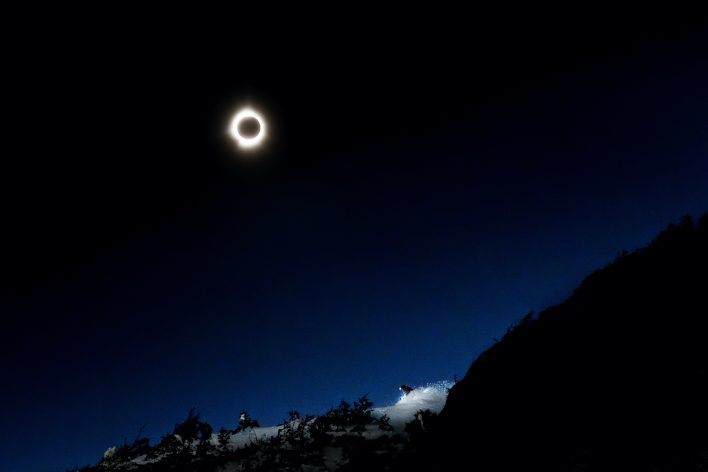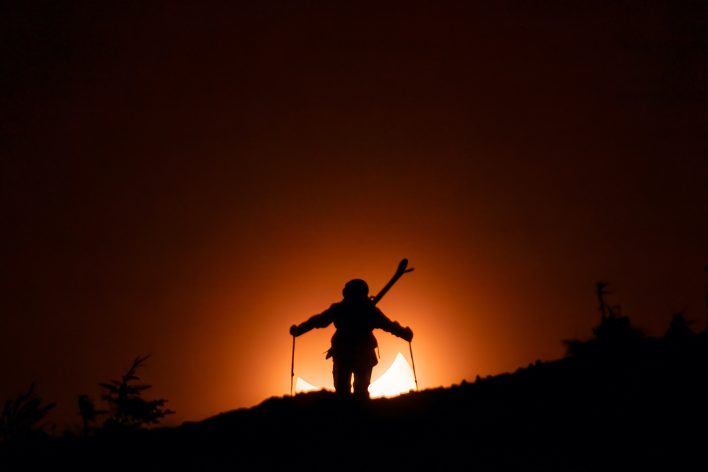Adam Kruszyna fell in love with adventure and developed his ski, mountaineering and photography skills in Vermont’s Green Mountains. Experiencing a solar eclipse there, with a skier in front of his lens was a dream come true. While brief, capturing that moment required extensive preparation. Kruszyna walks us through what it took to pull it off.
words and photos by Adam Kruszyna
When I heard that a total solar eclipse would pass over the Green Mountains, I knew that there was the potential for a once in a lifetime photograph. An opportunity not only to capture the eclipse in a location close to my heart, but also to showcase Vermont’s incredible skiing. As a bonus, I would get to experience this event in the company of an incredible group of friends.

My goals were to witness and experience a few moments of totality without the distraction of cameras, then capture a skier and totality in the same frame and capture a skier in front of the partially eclipsed sun as it set behind the ridge.
None of these would be easy. So much had to line up: eclipse, skier, photographer, weather and a patch of skiable snow. Planning began in January with the hope that come April 8, the weather and snow would align, too. Totality was set to occur at 3:26 p.m., with the sun still high in the sky. I considered mountains all over Northern Vermont—Mansfield, Jay Peak and Belvidere were top contenders. By early April, I had settled on Mount Mansfield, Vermont’s highest peak, whose steep summit ridge just barely checked all the boxes.
The week leading up to the eclipse, I spent almost every day on Mansfield searching for the precise spot to capture these frames. With the help of a somewhat accurate sun alignment app and direct observation of the sun’s position, I found spots that were nearly suitable. Dense trees, cliff bands and deep snow would make even small adjustments difficult. Each subsequent day I fine-tuned my positioning until finally I thought I’d found it: a small snowfield at the top of Hourglass Chute just off the Mansfield summit.
The plan was for a handful of skiers to ski the patch of snow as totality occurred, then again while the sun was still partially eclipsed. At 3:26 p.m., from my vantage point 600 feet below the ridge, the fully eclipsed sun was positioned just above the ridge. This alignment made it possible to capture the skier in motion and total eclipse in the same frame without image compositing (combining multiple images into a single image). At approximately 4:05 p.m., in that same location, the now partially eclipsed sun would set behind the ridgeline, allowing the skiers atop the ridge to eclipse the sun for the second photo I was after.
On April 6, I headed to the Taft Lodge on Mansfield with almost an expedition amount of gear, everything needed for three days of logistical planning and camera equipment preparation. On April 7, I organized a full-on practice run. Six skiers—Caleb Kessler, Matthew Scheeler, Ben Merz, Stan Plewak, Andrew Knight and Orion Cherney—provided a greater chance of catching the shot. Jonas Spaulding, Evan Daigle and Calvin May, talented videographers and skiers themselves, focused their efforts on capturing video clips for a short film (coming this fall).
The key to capturing these shots was timing and location. But the crew of skiers had no way to know whether they were in frame or not. Only I could see this from behind the lens. Due to the incredibly dark exposure, even I could just see the skiers as they passed near to or in front of the sun. To combat the lack of light, the skiers wore headlamps, and we backlit the scene with an additional floodlight. We precisely marked each location on the ridge with the hopes that they would shift only slightly with the movement of the sun the next day. With just moments to spare during the actual eclipse, rehearsing for the day-of was essential.

Come Monday April 8, against all odds, everything came together. There was fresh snow and clear skies—a rarity for April in Vermont. As totality approached, I carefully prepared my cameras, dialing in their settings and position while sparing some time to enjoy the first partial phase of the eclipse.
In the first 45 seconds of totality all six skiers passed through the frame. Click, click, click. My shutter snapped, as I changed settings on the fly to adapt to the light which was far darker than expected. In that moment, I captured skier and totality in the same frame. With over two minutes of totality left, all that was left to do was take in the experience.
As the total solar eclipse ended, we had a moment to collect ourselves. The team and I shifted gears to capture the partial eclipse. Amidst fleeting light and a flurry of frantic radio calls to adjust positioning, everything aligned for just long enough to catch a few frames as the skiers joined the moon in eclipsing the sun.
Accomplishing all three goals, the mission was a success, and a once in a lifetime experience I won’t be forgetting anytime soon.
Adam Kruszyna was born and raised in Vermont’s Northeast Kingdom where he was lucky to access the outdoors from a young age. His passion for skiing, mountaineering and photography have taken him deep into the mountains of his home state and beyond.
To read more from the untracked experience or to see our stories when they’re first published in print, subscribe.










Related posts: